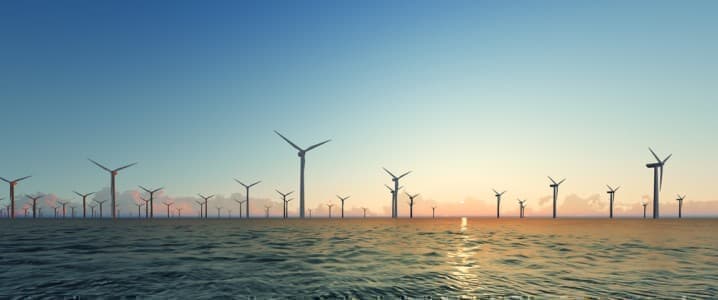The offshore wind industry is in crisis. Already this year, projects across Europe and the United States have been delayed or shelved thanks to a “perfect storm of supply chain delays, design flaws and higher costs” just when added clean energy capacity is needed the most. "If this turns into a prolonged pause of projects then without a doubt a lot of the 2030 renewables goals will be under pressure," Jon Wallace, an investment manager at Jupiter Asset Management, was quoted by Reuters this week.
The turmoil throughout the industry has certainly given investors pause, and has scared potential investors away from beginning new offshore wind projects in the near term. Just this month, a renewable energy auction in the United Kingdom failed to attract a single bid from offshore wind developers. The major deterrent in both European and U.S. markets is sharply rising costs related to offshore wind development.
“The expense associated with a typical US offshore project, before bonus tax credits related to the Inflation Reduction Act, has increased by 57% since 2021,” Bloomberg reported in August, citing figures from BloombergNEF. “Inflation in the cost of components and labor explain about 40% of that and the rest is tied to rising interest rates.” Indeed, offshore wind is currently two to five times more expensive than its onshore counterpart.
This extreme price hike doesn’t just spell trouble for potential future offshore developments; it’s also a big problem for deals that have already been inked. Any long-term development contracts signed before prices skyrocketed must either comprehensively re-negotiate those deals or shelve the project altogether.
The 50th anniversary of SPE Offshore Europe took place against the backdrop of this crisis last month in Aberdeen, Scotland. The purpose of the conference was to plan for the future of Europe’s offshore wind industry, a tall order in these times of turmoil. Four major themes emerged from the conference, according to reporting from analytics firm KcKinsey & Company.
Continued role of the North Sea as an energy hub
The North Sea, which has long been a key oil and gas hub for Europe’s homegrown energy market, is set for a major offshore wind makeover, with nine European countries pledging to build 300 GW of offshore wind by 2050.
Structural uncertainty
The current crisis plaguing the offshore industry has led to widespread instability, as has been furthermore compounded by other structural issues. According to McKinsey’s Bram Smeets, “the industry must also navigate the transition to renewable energy amidst rising supply chain costs, labor and skills shortages, continued increases in total energy demand, uncertainty over final investment decisions, geopolitical turmoil and shortages of materials critical to renewable technologies.” The offshore wind industry is not only plagued by the aforementioned skyrocketing development costs, it also has to contend with major potential rare Earth mineral shortages and all of the geopolitical difficulties that those supply chains embed.
Future of talent
The offshore wind industry is plagued by the same “green skills gap” and overall workforce shortage that has been causing issues and bottlenecks in the rest of the renewable energy sector. As the nature of the energy sector rapidly changes, education and vocational training has not been able to keep up with shifting market demands. As a result, many fossil fuel workers are facing joblessness while growing green energy firms are desperate to find workers.
Cross-value chain collaboration
The unprecedented scale of the green energy transition, as well as the climate crisis that we will face without it, require a level of international and cross-sectoral coordination that we’ve never seen before. Offshore wind is an essential piece of any viable pathway to avoiding catastrophic climate change, but course-correcting the industry won’t be easy – and it won’t be possible at all without multifaceted coordination and support. In the words of Adam Davey, Associate Partner at McKinsey said: “The speed and scale of the energy transition will mean all stakeholders need to be partners on the journey and it needs to work for all parties. This could involve streamlining and alignment of project approvals and regulatory consenting, harmonization of standards, ‘sector coupling’ such as offshore wind-to-hydrogen and consortia spanning separate industries from oil and gas to wind and power.“
All four of these themes are essential entry points for creating a successful, sustainable and resilient offshore wind sector – and therefore a successful, sustainable and resilient energy sector writ large. The reason that offshore wind is so crucial to global decarbonization pathways is the scale and efficiency of the technology. Offshore wind turbines stand taller than skyscrapers and are exposed to the strength and consistency of ocean wind patterns, making them a much more productive and dependable form of wind energy production than onshore wind farms. Offshore wind-power potential off the coast of the mainland United States alone is estimated at 4.2 terawatts – nearly four times the entire capacity of all types of generation operating today. That’s why getting the sector into shape is absolutely essential – and urgent – for meeting global climate goals.
By Haley Zaremba for Oilprice.com
More Top Reads From Oilprice.com:
- DOE Eyes Historic $1 Billion Loan To Kickstart U.S. Lithium Boom
- Budget Airlines Defy Travel Slowdown Concerns
- Electrically Ignited Fuel: The Future Of Safe Energy


















